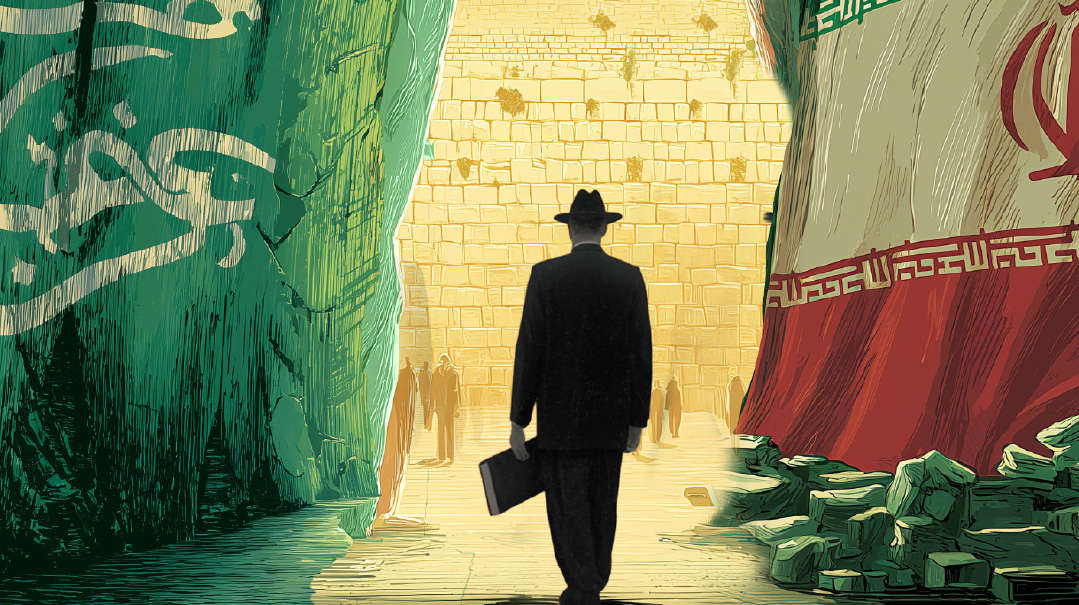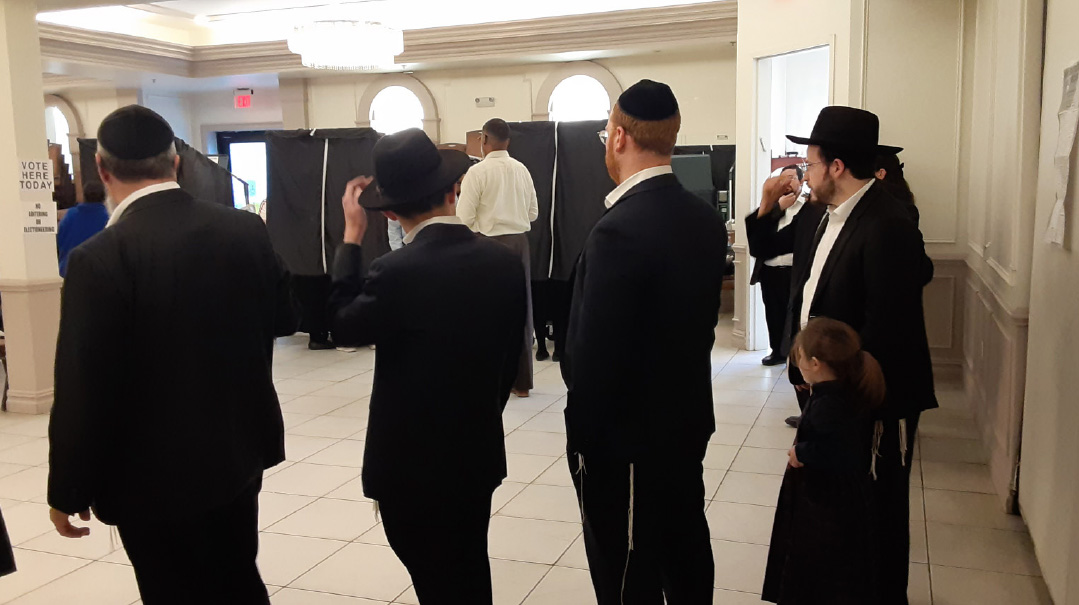The Key to Defeating Persia
| June 24, 2025How do we earn Hashem’s boundless mercy and merit a full yeshuah?

AS
the Rambam exhorts us in Hilchos Teshuvah: “Uru yesheinim mishenaschem (Awaken, you sleepers, from your slumber].” Now is the time to truly wake up.
After enduring a long history plagued by bitter exiles, we now find ourselves in the midst of Galus Yishmael, which the Zohar (2:17a) calls “the most difficult of them all.” Myriad sources (see Pirkei D’Rabi Eliezer; Rav Saadia Gaon on Sefer Daniel (7:7); Rav Chaim Vital on Tehillim) all point to the war against the scions of Yishmael as the final exile we must overcome before crossing the long-awaited threshold to Yemos Hamashiach. But the last nation that will engage us in direct combat (Targum Yonasan, Targum Yerushalmi, Esther Rabbah) is Paras/Persia, the nefarious country of modern-day Iran, consumed by a raging desire to annihilate the Jewish People and conquer our cherished land (Malbim on Yechezkel).
Down through the millennia, we have persevered, and as Rav Yaakov Emden points out in the introduction to Siddur Beis Yaakov, we have manifested the greatest miracle of all time: the survival of Klal Yisrael through pogroms, crusades, exiles, and perennial attempts to eradicate us. The Navi Shmuel tells us (Shmuel I, 15:29), “Netzach Yisrael lo yeshaker”; with HaKadosh Baruch Hu watching over His am hanivchar, our perpetuity is fully secure. While we might not always know what our immediate future holds in store, we can rest assured that Avinu ShebaShamayim holds us in His ever-loving hands.
With the horrors of the Holocaust forever etched in our minds, we are currently up against Hamas, Hezbollah, the Houthis — and now war directly with Iran. The evil descendants of Yishmael and Paras have joined forces at the end of days. Nisgaber k’ari, awake and ready for action. What is the chief message for us?
WE begin with a fascinating remez from Rav Menachem Mendel of Shklov, one of the closest disciples of the Vilna Gaon. In his Kisvei HaGram”am, he explains the Gemara in Berachos (54a–b) that makes reference to two “lepers” (metzora’im) known as “Es” and “Vaheiv” (based on the pasuk in Chukas, Bamidbar 21:14), walking in the desert behind the Machaneh Yisrael. The combined gematria, he writes, of Es (401) and Vaheiv (13) is 414 — the same total as the names of the respective “founders” of Christianity (Malchus Romi-Edom) and Islam (Malchus Paras-Yishmael): “Yeishu” (316) and Muchmad (Muhammad, 98).
(As an aside, the Chida explains that the term Chazal use to refer to a heretic is “min,” which is itself an acronym for “maaminei Yeishu notzri.”)
Always behind us, right on our tails, these two figurative “lepers” have caused indescribable grief and agony to Bnei Yisrael. The pinnacle of Romi’s atrocities was the Holocaust. On the heels of their Christian counterparts, the followers of Muchmad/Muhammad persist in unleashing incessant terror on the Jewish People: wars, intifadas, suicide bombers, missile barrages from within Israel… and now ballistic missiles and explosive drones raining in from Iran, the malevolent matriarch of many terror proxies.
Let us now turn to the words of the Maharal in his classic Netzach Yisrael (chapter 21). Based on the Gemara in Avodah Zarah (2b), it is evident that the two malchuyos whose kingdoms will still exist until Mashiach’s arrival will be those of Rome/Edom (Christianity) and Paras/Iran (Islam). While the mighty nations of the world will eventually battle one another (Pesikta Rabbasi, parshah #36), the last one to persecute us is Paras/Persia. So where exactly does Yishmael fit in?
The Maharal asserts (Chiddushei Aggados) that “Malchus Yishmael u’Malchus Paras — hakol malchus echad.” They are very closely related and share sundry character traits (see Megillah 11a). They have now linked arms to wage a united war against Hashem’s am hanivchar. Hence, their omission from the list of various exiles to which we have been subjected is readily understandable: Yishmael’s progeny will be absorbed into Malchus Paras. (The Rokeiach even notes [parshas Vayeishev 37:25] that the appellation for Arabs is “Aravim,” a name that instantly conveys the “mixed” nature of Yishmael’s assorted offspring.)
But there is even more to that choice of name. A hallmark of the Arabs’ sheer evil, notes the Seforno (parshas Vayeira, 21:9), is their blatant disregard for and denial of history. Among their pathetic claims: not Sarah, but rather Hagar was the primary wife of Avraham; Yitzchak was not the chosen son of Avraham (“nisabrah mei’Avimelech”) — that was, rather, their ancestor Yishmael. (This continues into our times: The land of Israel belongs exclusively to them, there was never a Temple of Solomon built atop Har HaMoriah, etc.)
The Alter MiKelm was therefore astounded (Kol HaTorah, vol. #62, Tishrei 5767, p. 293) by the incredible Divine Hashgachah in these proud offspring of Yishmael opting for the name “Aravim” (connoting a random “irvuvya,” hodgepodge). After all, if your intent was to strip Yitzchak of his true pedigree and falsely claim that you are the sole heirs of Avraham HaIvri (Lech Lecha, 14:13), why would you not instead usurp the lofty title of “Ivrim”?
The answer, of course, is that, as HaKadosh Baruch Hu told Avraham Avinu, “ki v’Yitzchak yikarei lecha zara” (Vayeira, 21:12), Yishmael’s offspring can never be considered “Ivrim” — that coveted status belongs solely to Yitzchak and his illustrious descendants. Concludes the Alter, “v’ein mofeis ha’emunah gadol mizeh.”
A defining aspect of Yishmael, we have thus observed, is that his existential identity is entirely built on sheker, utter falsehood through and through, to his core. It is no surprise, therefore, that the Gemara (Succah 52b) records that the Yishmaelim are counted among the four things HaKadosh Baruch Hu “regrets” having created. The idea of Hashem “regretting,” explained Rav Moshe Shapira, is that these four acts of creation run contrary to the tachlis habriah — their actions are antithetical to the ultimate goal and purpose of HaKadosh Baruch Hu in creating His world.
Take special note of the following: Some of Klal Yisrael’s worst enemies and miscreants merited to have their utterances appear in the hallowed pages of Chumash — Eisav, Lavan, Balak, Bilaam, and numerous others. Can you recall a single saying of Yishmael recorded in the sacred pages of our Torah? Of course not. Not even a single word.
Because Yishmael, characterized as a “pere adam” (Lech Lecha, 16:12), a wild-donkey of a man, is entirely rooted in sheker, and nothing that ever escaped his lips belongs in our Toras Emes. They are determined to deny us our true essence and history and are bent on destroying us, the anshei emes engrossed eternally in Toras Emes, at all costs. Far worse than being a mere “sonei,” an enemy and hated rival, of which we have had to face oh-so-many, Yishmael is classified — writes Rabbeinu Bechaye (parshas Nitzavim, 30:7) — as an “oyeiv,” an enemy who despises us to the point of longing to hear us scream “oy va-voy” (comprised of the same letters). Hashem yerachem aleinu.
How, then, do we earn Hashem’s boundless mercy and merit a full yeshuah?
To overcome the combined belligerence of Yishmael and Paras that we presently face, we must look toward the unique power of Yitzchak, who represents the “zeh le’umas zeh” of Yishmael, and toward the actions of Mordechai and Esther, the Purim heroes who helped secure our salvation from Paras the first time around.
Yishmael is described as a “roveh kashas” (Vayeira, 21:20), an accomplished archer. Nowadays that translates into the modern-day equivalent: shooting rockets and missiles our way from afar. Concealing themselves at a distance, they aim relentless fusillades of missile attacks — just as Yishmael aimed his arrows at his half-brother Yitzchak (Rashi, Vayeira, 21:10).
Yitzchak Avinu — whom the Zohar Chadash calls “amud ha’avodah u’tefillah” (Chukas 84a), and who gifted us with, not simply an afternoon prayer, but one called “Minchah,” as through the Akeidas Yitzchak, he demonstrated what it meant to offer oneself fully to HaKadosh Baruch Hu — is the father who extols his select son Yaakov for the supremacy of his “kol.” Hakol kol Yaakov (Toldos, 27:22) will vanquish the arms of Eisav and the missiles cast from the hands of Yishmael.
Yaakov makes that message very clear, in turn, when he declares to his son Yosef that he conquered his enemies “b’charbi uv’kashti” (Vayechi, 48:22), which the Targum explains is a reference to his potent koach hatefillah. This is not a mere mashal or drush, notes Rav Nosson Meir Wachtfogel in his Leket Reshimos on tefillah (p. 54), but the literal understanding: We defeat our adversaries by invoking the pure power of our kol, the potency of our koach hatefillah.
Heartfelt and sincere prayer is our literal sword and bow in warfare. HaKadosh Baruch Hu is always there to shield us and procure our victory. But He yearns for us to cry out to Him, to put our hopes, dreams, and aspirations exclusively in His omnipotent Hands.
WE certainly learned that lesson Purim time. Facing extinction in Achashveirosh’s Paras, Mordechai and Esther knew that turning to HaKadosh Baruch Hu in fasting and fervent tefillah — all of Klal Yisrael together: “Lech kenos es kol haYehudim” (Esther, 4:16) — is the key ingredient in securing our salvation. That is how we receive siyata d’Shmaya and emerge victorious. Time and time again.
Against the coalescing forces of Yishmael and Paras, that is what we must tap into with all of our koach. Together in heartfelt tefillah and genuine tears, in utter subjugation before HaKadosh Baruch Hu, that will lead us yet again to a yeshuah, and a full-fledged geulah b’karov.
Remember the “Es” and “Vaheiv” reference mentioned earlier? Well, intermingle those very letters (mix up the names of those evil ones), and the upshot yields: “V’ahavta.”
Continue to truly love HaKadosh Baruch Hu “b’chol levavecha uv’chol nafshecha” and give Him your lev v’nefesh mamash in passionate prayer. Hashem will have mercy on us (“V’ahavta” has the same gematria of 414, as does “racheim aleinu”), and we will prevail this time like never before.
We will all then also enjoy Eretz Yisrael’s physical and spiritual splendor, “v’tovah ha’aretz meod meod” (gematria 414, in Shelach, 14:7) with a geulah sheleimah (also 414, without the vav).
And we, the young cub now turned lion (Balak, 23:24), will rise to greatness — “v’ha’ari yaaleh l’gedulah” (414, im hakollel) — once and for all.
Rabbi Eytan Feiner is the Rav of Congregation Kneseth Israel, better known as the renowned "White Shul," located in Far Rockaway, New York, and also serves as the Rav of Chai Lifeline's Camp Simcha.
(Originally featured in Mishpacha, Issue 1067)
Oops! We could not locate your form.







